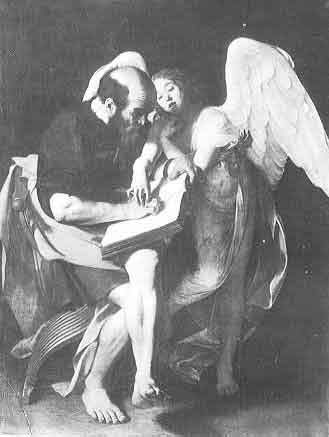A typical 'scandal' of this kind flared up round Caravaggio(1571-1610), a very bold and revolutionary Italian artist, who worked round about 1600. He was given the task of painting a picture of St Matthew for the alter of a church in Rome. The saint was to be represented writing the gospel, and, to show that the gospels were the word of God, an angel was to be represented inspiring his writings.
激起這種“公憤”的一個典型例子,是卡拉瓦喬惹出的亂子;卡拉瓦喬是一位有著大膽改革精神的意大利藝術家,從事藝術活動的時間大約在公元1600年左右。當時他受命給羅馬一座教堂的祭壇畫一幅圣馬太的像。圣徒應該被畫成正在那里寫作福音,為了表現出福音是上帝的圣諭,還應該畫一個天使正在為他的作品賦予超凡入圣的靈感。
Caravaggio, who was a very imaginative and uncompromising young artist, thought hard about what it must have been like when an elderly, poor, working man, a simple publican, suddenly had to sit down to write a book. And so he painted a picture of St matthew with a bald head and bare dusty feet, awkwardly gripping the huge volume, anxiously wrinkling his brow under the unaccustomed strain of writing. By his side he painted a youthful angel, who seems just to have arrived from on high, andwho gently guides the labourer's hand as a teacher may do to a child.
卡拉瓦喬是一個堅定不屈、富于想象的青年藝術家,他苦苦地思索那個年邁的貧苦勞動者,一個小收稅人,突然不得不坐下來寫書時,場面必然會是什么樣子。于是他把圣馬太畫成這么一幅樣子:禿頂,赤著泥腳,笨拙地抓著一個大本子,由于不習慣于寫作而感到緊張,焦灼地皺起眉頭。在圣馬太旁邊,他畫了一個年輕的天使,仿佛剛從天外飛來,像老師教小孩子一樣,溫柔地把著這位勞動者的手。












